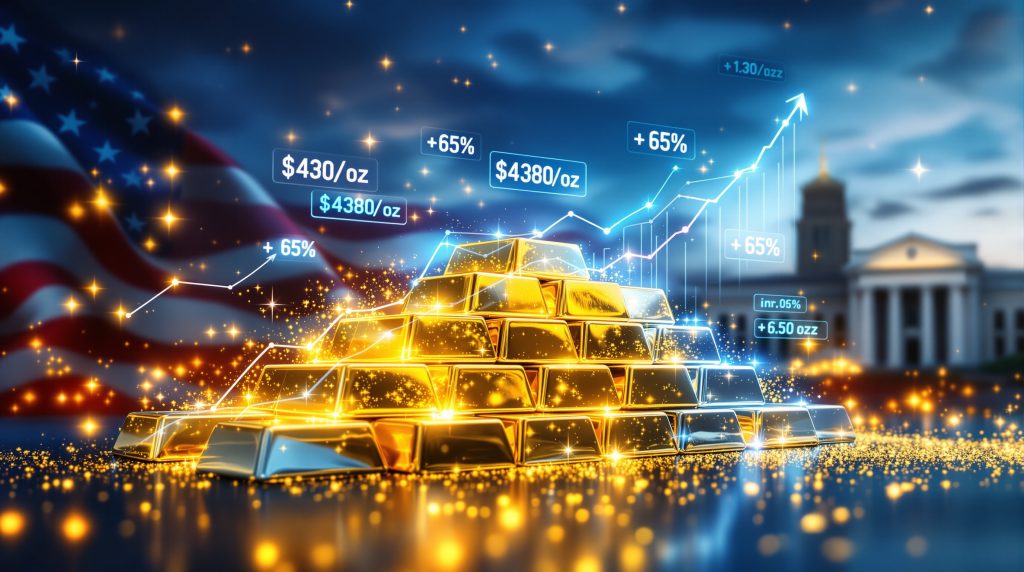The precious metals market witnessed extraordinary developments in October 2025, with gold and silver prices hit records that sent shockwaves through global financial markets. Gold reached an unprecedented $4,379.96 per ounce on October 16, 2025, representing a staggering 65% surge for the year, while silver simultaneously touched its all-time high of $54.3775 per ounce. This remarkable performance positions gold market performance on track for its biggest weekly gain since the pandemic-driven rally of 2020.
Why Are Precious Metals Breaking All-Time Records in 2025?
The convergence of multiple economic uncertainties has created an unprecedented environment for precious metal accumulation. Regional banking sector stress became evident when two US regional lenders disclosed problems with loans involving fraud allegations on the same day precious metals reached their peaks. These disclosures heightened concerns about broader borrower creditworthiness across the financial system.
Credit market stress indicators extend beyond isolated banking incidents. The ongoing US government shutdown has delayed the release of crucial economic data, creating an information vacuum that amplifies market uncertainty. When resolution occurs, analysts expect a flood of economic information that may reveal underlying weaknesses requiring additional monetary policy support.
Financial institutions and individual investors have responded to this uncertainty by increasing their precious metal allocations. The sustained demand reflects growing concerns about:
• Fiscal debt levels reaching critical thresholds
• Central bank independence facing political pressures
• Economic data reliability amid government disruptions
• Credit quality deterioration across lending sectors
Federal Reserve Policy Shifts Favour Non-Yielding Assets
Federal Reserve Chair Jerome Powell signalled the central bank remains on track to deliver another quarter-point rate reduction in October 2025, with market participants pricing in expectations for at least one jumbo rate cut by year-end. This dovish policy trajectory creates favourable conditions for gold price analysis and silver, which benefit when the opportunity cost of holding non-yielding assets decreases.
Real interest rate calculations have become increasingly supportive of precious metals. When nominal interest rates decline while inflation expectations remain stable or elevated, the relative attractiveness of assets that don't pay interest or dividends improves significantly. This mathematical relationship has been a primary driver behind the exceptional performance of both gold and silver.
Market sentiment analysis reveals that central bank communication regarding future policy paths has amplified precious metal demand. Traders have positioned aggressively for additional monetary easing, with ETF inflows reaching almost 11 million ounces for silver alone during the week ending October 16, 2025.
How Do Geopolitical Tensions Amplify Precious Metal Rallies?
US-China Trade Relations Create Market Volatility
The escalation of US-China trade tensions has provided substantial support for precious metal prices throughout 2025. In late September, the US Commerce Department published expanded sanctions rules that widened restrictions to companies affiliated with blacklisted Chinese firms, extending beyond directly listed entities to their corporate networks.
These regulatory changes have created significant supply chain implications across multiple industries. The expanded sanctions mechanism affects not just primary targets but entire business ecosystems, creating uncertainty about future trade flows and commercial relationships between the world's two largest economies.
Chinese Commerce Minister Wang Wentao responded on October 16, 2025, by attributing the recent escalation to American policies and issuing warnings about the risks of economic decoupling. This high-level diplomatic friction has reinforced safe-haven demand for precious metals among institutional investors seeking currency hedging alternatives.
Currency hedging strategies have become increasingly sophisticated as institutions prepare for potential disruptions to traditional financial mechanisms. The precious metals market has benefited from this institutional repositioning, with central bank purchases representing one of the key underpinnings of gold's exceptional performance.
Global Decoupling Fears Boost Alternative Store-of-Value Assets
International trade policy uncertainty has created a new paradigm for sovereign wealth preservation. Nations are increasingly evaluating their reserve compositions and seeking alternatives to traditional currency holdings that may face political or economic restrictions.
Cross-border investment flow disruptions have become more frequent and severe, prompting institutional investors to diversify into assets that maintain value across different jurisdictions. Precious metals offer unique advantages in this environment:
• Universal recognition across all monetary systems
• Physical portability independent of digital infrastructure
• Historical precedent as crisis-period stores of value
• Limited counterparty risk compared to paper assets
The fear of economic decoupling between major economies has accelerated these trends, with sovereign wealth funds and central banks increasing their precious metal allocations as insurance against systemic disruptions.
What Technical Factors Are Driving Silver's Exceptional Performance?
London Market Liquidity Crisis Explained
The London silver market experienced a severe liquidity shortage that triggered worldwide demand for physical metal. This crisis manifested through benchmark prices soaring above futures prices in New York, creating profitable arbitrage opportunities that drew metal from American storage facilities.
Warehouse withdrawal patterns revealed the extent of supply pressure, with over 15 million ounces withdrawn from Comex-linked warehouses in New York during the week ending October 16, 2025. Industry analysis suggests much of this silver was redirected to London to address the acute shortage.
The geographic arbitrage mechanism functions when spot prices in London trade at premiums sufficient to cover transportation, insurance, and storage costs for moving metal from New York. This price differential created economic incentives for large-scale physical movements across the Atlantic.
Physical delivery constraints have intensified as available inventory struggles to meet simultaneous demand from multiple sources. The London crisis represents more than temporary tightness; it reflects structural changes in silver market squeeze dynamics where paper contracts increasingly struggle to satisfy physical delivery requirements.
ETF Inflows Create Additional Supply Pressure
Exchange-traded fund accumulation has accelerated dramatically, with silver ETFs adding almost 11 million ounces during the same week that witnessed massive warehouse withdrawals. This dual pressure from both geographic arbitrage and ETF backing requirements has intensified supply constraints.
Institutional versus retail investment patterns show distinct characteristics in the current environment. Large institutional players have focused on securing physical delivery capabilities, while retail investors have increasingly utilised ETF structures for precious metal exposure.
Physical backing requirements for ETFs create additional competition for available silver inventory. Unlike paper contracts that can be settled financially, ETF structures typically require actual metal holdings to back their shares, creating persistent demand for deliverable inventory.
The combination of London market tightness and ETF inflow acceleration has created a feedback loop where higher prices attract additional investment, which in turn requires more physical metal to be withdrawn from already strained inventories.
Which Market Dynamics Distinguish 2025's Rally from Previous Cycles?
Central Bank Purchasing Patterns
Central bank gold purchasing has emerged as a defining characteristic of the 2025 rally, distinguishing it from previous cycles driven primarily by private investment demand. Sovereign institutions have implemented systematic accumulation strategies as part of broader reserve diversification initiatives.
The scope of central bank participation extends beyond traditional gold-holding nations. Emerging market central banks have accelerated their precious metal acquisitions as they seek to reduce dependence on traditional reserve currencies that may face political or economic pressures.
Reserve composition shifts reflect changing geopolitical realities where traditional safe-haven assets face unprecedented challenges. Central banks have increased their precious metal allocations not just as portfolio diversification but as insurance against monetary system disruptions.
Sovereign purchasing patterns demonstrate long-term commitment rather than tactical trading. These institutions typically hold precious metals for extended periods, removing substantial quantities from circulating supply and providing sustained demand support.
Industrial Demand Evolution
Silver's industrial applications have evolved significantly, creating new demand dynamics that differentiate current market conditions from historical precedents. The green energy transition has increased silver consumption across solar panel manufacturing, electric vehicle components, and energy storage systems.
Technology sector requirements continue expanding as digital infrastructure development accelerates. Silver's unique properties make it irreplaceable in numerous high-tech applications, creating inelastic demand that supports price appreciation even at elevated levels.
Supply-demand imbalance projections suggest structural deficits may persist across multiple market cycles. Mining production capacity faces constraints from declining ore grades, deeper extraction requirements, and increasingly complex environmental regulations.
The intersection of industrial demand growth and investment demand surge has created unprecedented market dynamics where traditional price elasticity assumptions no longer apply effectively.
How Do Current Price Levels Compare to Historical Benchmarks?
Gold's 65% Annual Surge in Context
| Time Period | Price Range | Key Drivers |
|---|---|---|
| 2011 Peak | $1,895/oz | Financial crisis aftermath |
| 2020 High | $2,067/oz | Pandemic uncertainty |
| 2025 Record | $4,379.96/oz | Multi-factor convergence |
The progression from 2020's pandemic peak to 2025's record represents approximately 111.6% appreciation over five years. This performance exceeds typical bull market cycles and reflects the extraordinary nature of current supporting factors.
Gold futures settled at $4,380.7 per ounce with a 3.68% daily gain, while the weekly performance positioned precious metals for their strongest period since the initial pandemic response. This momentum suggests broad-based institutional and retail participation rather than speculative positioning.
Historical precedent analysis reveals that previous record-breaking rallies typically occurred during singular crisis events. However, gold and silver prices hit records in 2025 distinguished itself through multiple simultaneous catalysts creating reinforcing demand pressures.
Silver's Historic Breakout Analysis
Silver's achievement of $54.3775 per ounce represents the culmination of years of supply-demand imbalance pressures. The gold-to-silver ratio calculated at approximately 81.9:1 suggests potential for additional silver appreciation if historical relationships reassert.
Previous bull market cycles typically witnessed silver outperforming gold during rally phases, with the metal demonstrating higher volatility characteristics. The current cycle has maintained this relationship while achieving unprecedented absolute price levels.
Industrial versus investment demand proportions have shifted significantly compared to historical patterns. Investment demand has accelerated whilst industrial applications continue expanding, creating dual pressure points that support sustained price appreciation.
What Investment Strategies Are Emerging Around Record Prices?
Portfolio Allocation Adjustments
Traditional precious metal allocation recommendations of 5-10% of total portfolio value face reconsideration as record prices challenge conventional wisdom. Risk-adjusted return calculations at current levels require updated analysis incorporating elevated volatility and correlation patterns.
Diversification benefits during market stress periods have proven substantial, with precious metals providing negative correlation to traditional equity and bond markets during crisis periods. This portfolio protection value has attracted institutional interest despite elevated price entry points.
Modern portfolio theory applications must account for the changing dynamics of precious metals as both inflation hedges and crisis insurance. The multiple roles these assets serve complicate traditional optimisation models and require sophisticated risk assessment frameworks.
Physical vs. Paper Precious Metal Considerations
The London silver market liquidity crisis and 15+ million ounce Comex warehouse withdrawals have highlighted distinctions between paper contracts and physical delivery capabilities. Physical metal has commanded premiums when supply tightness emerges, creating pricing dislocations between different investment vehicles.
Storage and insurance cost factors have become more significant considerations as precious metal values reach historic levels. Secure storage capacity faces increasing demand, whilst insurance premiums reflect elevated values and potential theft risks.
Counterparty risk evaluation has gained importance as financial system stress increases. Physical precious metals eliminate counterparty risk entirely, whilst ETF structures require assessment of custodian reliability and regulatory protection mechanisms.
Liquidity differences between investment vehicles have become pronounced during volatile periods. Physical markets may experience wider bid-ask spreads and longer settlement times compared to paper alternatives during stress periods.
Where Could Prices Head from These Historic Levels?
Technical Analysis Indicators
Gold's trajectory toward its biggest weekly gain since 2020 suggests broad-based participation and momentum continuation potential. Volume analysis indicates institutional involvement rather than purely speculative positioning, supporting sustainability arguments.
Support level identification becomes challenging when assets reach all-time highs with no historical resistance levels for guidance. Previous resistance zones may now serve as psychological support, though their effectiveness remains untested at current levels.
Momentum indicators and trend sustainability metrics require careful interpretation given the extraordinary nature of 2025's rally. Traditional technical analysis tools may have limited predictive value during unprecedented market conditions.
Market participation breadth analysis reveals involvement across multiple investor categories, from central banks to retail ETF purchasers. This diverse participation base may provide more stable demand foundations compared to narrowly-driven rallies.
Fundamental Outlook Assessment
Supply constraints face mining production companies as ore grades decline and extraction costs increase. Environmental regulations and permitting challenges create additional obstacles for expanding production capacity to meet growing demand.
The US government shutdown resolution is expected to release postponed economic data that could provide evidence supporting additional monetary policy easing. This information release may catalyse further precious metal demand if economic weakness becomes apparent.
Federal Reserve policy trajectory expectations suggest continued accommodative stance through year-end 2025. Market positioning for potential jumbo rate cuts creates ongoing support for non-yielding assets like gold and silver.
Furthermore, gold price forecast scenario planning must account for multiple potential outcomes ranging from continued policy accommodation to unexpected economic resilience requiring policy tightening. Each scenario carries different implications for precious metal demand sustainability.
Frequently Asked Questions About Record Precious Metal Prices
Is This Rally Sustainable Long-Term?
The durability of 2025's precious metal rally depends on the continuation of its multiple supporting factors. Unlike previous cycles driven by singular events, the current environment reflects convergence of monetary policy accommodation, geopolitical tensions, trade disputes, fiscal concerns, and financial system stress.
Historical precedent from the 2020 rally provides some context for exceptional precious metal performance during crisis periods. However, gold and silver prices hit records in the current cycle's duration and magnitude suggest different underlying dynamics requiring separate analysis frameworks.
Market cycle duration patterns historically show precious metal bull markets lasting multiple years with periodic corrections. After 65% annual gains for gold, some consolidation appears probable, though the timing and extent depend on fundamental factor persistence.
Correction probability assessments must balance technical oversold conditions against persistent fundamental demand drivers. The presence of central bank purchasing and structural supply-demand imbalances may limit correction depth compared to purely speculative rallies.
How Should Investors Position for Continued Volatility?
Risk management strategies should acknowledge that precious metals at record levels carry elevated volatility potential. Position sizing becomes critical when assets have appreciated significantly and may face increased price swings.
Dollar-cost averaging approaches may help investors manage entry point risk when purchasing precious metals at elevated levels. Systematic accumulation can reduce the impact of short-term price fluctuations on overall portfolio performance.
Exit strategy considerations require clear criteria for profit-taking or loss limitation. Investors should establish specific price levels or fundamental changes that would trigger position adjustments before emotional decision-making becomes necessary.
Geographic exposure diversification across different precious metal markets may provide additional risk mitigation. The London silver crisis demonstrated how regional supply constraints can create pricing dislocations between markets.
Key Takeaways for Precious Metal Market Participants
Critical Monitoring Points
Federal Reserve policy announcement impacts remain the primary catalyst for precious metal price movements. Any shifts in the expected trajectory of quarter-point cuts or potential jumbo reductions will significantly influence market sentiment and positioning.
Geopolitical development tracking requires attention to US-China trade relations, Commerce Department sanctions implementation, and responses from affected nations. The October 16, 2025 warnings from Chinese officials about economic decoupling represent escalation risks that could amplify safe-haven demand.
Supply chain disruption indicators deserve monitoring as they affect both precious metal availability and broader economic conditions. The 15+ million ounce silver withdrawal from Comex warehouses illustrates how physical market constraints can create price pressures independent of financial factors.
Regional banking sector health indicators may provide early warning signals for broader credit market stress. The fraud allegations disclosed on October 16, 2025 represent potential symptoms of more widespread credit quality deterioration.
Strategic Positioning Considerations
Market timing versus long-term holding strategies present different risk-reward profiles at current price levels. The convergence of monetary policy uncertainty, geopolitical tensions, and physical market constraints suggests fundamental drivers may persist beyond short-term volatility periods.
Currency hedge effectiveness has become increasingly important as traditional reserve assets face political and economic pressures. Precious metals provide portfolio protection against currency devaluation risks that may intensify during periods of international tension.
Physical delivery capabilities have proven crucial during supply constraint periods. Investors prioritising ultimate security may prefer physical holdings despite storage and insurance costs, whilst those seeking liquidity may accept counterparty risks associated with paper alternatives.
The extraordinary environment created by simultaneous monetary policy accommodation, geopolitical tensions, and physical market supply constraints has generated unprecedented conditions for precious metals. Market participants should focus on understanding these fundamental drivers rather than attempting to time short-term price movements, as the convergence of multiple supporting factors suggests potential for continued strength despite elevated starting points.
Important Disclaimer: This analysis involves forecasts, speculation, and financial market assessment that may not materialise as expected. Precious metal investments carry significant risks including price volatility, storage costs, and potential capital loss. Past performance does not guarantee future results, and investors should conduct thorough research and consider professional advice before making investment decisions. Market conditions can change rapidly, and the factors supporting current precious metal prices may shift without warning.
Ready to Capitalise on the Next Major Precious Metal Discovery?
Discovery Alert delivers instant notifications on significant ASX mineral discoveries using its proprietary Discovery IQ model, transforming complex geological data into actionable investment insights when precious metals reach historic valuations. Explore how major mineral discoveries have generated exceptional returns throughout market history and begin your 30-day free trial today to position yourself ahead of the market.




